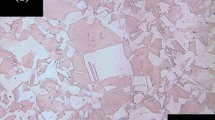Abstract
In this study, a comparison of the tensile behavior of fully nanotwinned Cu–6 wt.%Al, Cu–2 wt.%Al, and Cu–10 wt.%Ni with stacking fault energies (SFEs) of 6, 37, and 60 mJ/m2, respectively is presented. The samples displayed yield strengths ranging from 830 to 1340 MPa, varying with both alloy content and microstructural parameters. All samples showed low ductility, even though there are tilted twin boundaries present in Cu–10 wt.%Ni. The influence of varying grain width is presented for each alloy and related to both the activation volume and SFE [Figs. 3(a)–3(c)].





Similar content being viewed by others
References
L. Lu: Current progress of mechanical properties of metals with nano-scale twins. J. Mater. Sci. Technol. 24, 473 (2008).
L. Lu, Y. Shen, X. Chen, L. Qian and K. Lu: Ultrahigh strength and high electrical conductivity in copper. Science 304, 422 (2004).
Y. Zhao, I.C. Cheng, M.E. Kassner and A.M. Hodge: The effect of nano-twins on the corrosion behavior of copper. Acta Mater. 67, 181 (2014).
Y. Zhao, T.A. Furnish, M.E. Kassner and A.M. Hodge: Thermal stability of highly nanotwinned copper: The role of grain boundaries and texture. J. Mater. Res. 27, 3049 (2012).
X. Zhang and A. Misra: Superior thermal stability of coherent twin boundaries in nanotwinned metals. Scr. Mater. 66, 860 (2012).
F.K. Yan, G.Z. Liu, N.R. Tao and K. Lu: Strength and ductility of 316 L aus-tenitic stainless steel strengthened by nano-scale twin bundles. Acta Mater. 60, 1059 (2012).
G.H. Xiao, N.R. Tao and K. Lu: Strength-ductility combination of nano-structured Cu–Zn alloy with nanotwin bundles. Scr. Mater. 65, 119 (2011).
K. Lu, F.K. Yan, H.T. Wang and N.R. Tao: Strengthening austenitic steels by using nanotwinned austenitic grains. Scr. Mater. 66, 878 (2012).
H.T. Wang, N.R. Tao and K. Lu: Strengthening an austenitic Fe–Mn steel using nanotwinned austenitic grains. Acta Mater. 60, 4027 (2012).
L. Lu, X. Chen, X. Huang and K. Lu: Revealing the maximum strength in nanotwinned copper. Science 323, 607 (2009).
X.H. Chen, L. Lu and K. Lu: Grain size dependence of tensile properties in ultrafine-grained Cu with nanoscale twins. Scr. Mater. 64, 311 (2011).
W. Yujie: Scaling of maximum strength with grain size in nanotwinned fcc metals. Phys. Rev. B: Condens. Matter 83, 132104 (4 pp.) (2011).
L. Zhu, H. Ruan, X. Li, M. Dao, H. Gao and J. Lu: Modeling grain size dependent optimal twin spacing for achieving ultimate high strength and related high ductility in nanotwinned metals. Acta Mater. 59, 5544 (2011).
F.I. Grace and M.C. Inman: Influence of stacking fault energy on dislocation configurations in shock-deformed metals. Metallography 3, 89 (1970).
W. Li, S. Lu, Q.-M. Hu, S.K. Kwon, B. Johansson and L. Vitos: Generalized stacking fault energies of alloys. J. Phys., Condens. Matter 26, 265005 (2014).
A. Rohatgi, K.S. Vecchio and G.T. Gray III: The influence of stacking fault energy on the mechanical behavior of Cu and Cu–Al alloys: Deformation twinning, work hardening, and dynamic recovery. Metall. Mater. Trans. A 32A, 135 (2001).
L. Velasco and A.M. Hodge: The mobility of growth twins synthesized by sputtering: Tailoring the twin thickness. Acta Mater. 109, 142 (2016).
N.M. Heckman, L. Velasco and A.M. Hodge: Influence of twin thickness and grain size on the tensile behavior of fully nanotwinned CuAl alloys. Adv. Eng. Mater. 18, 918 (2016).
L. Sun, X. He and J. Lu: Atomistic simulation study on twin orientation and spacing distribution effects on nanotwinned Cu films. Philos. Mag. 95, 3467 (2015).
Z. You, X. Li, L. Gui, Q. Lu, T. Zhu, H. Gao and L. Lu: Plastic anisotropy and associated deformation mechanisms in nanotwinned metals. Acta Mater. 61, 217 (2013).
T. Zhu and H. Gao: Plastic deformation mechanism in nanotwinned metals: An insight from molecular dynamics and mechanistic modeling. Scr. Mater. 66, 843 (2012).
P. Gu, M. Dao, R.J. Asaro and S. Suresh: A unified mechanistic model for size-dependent deformation in nanocrystalline and nanotwinned metals. Acta Mater. 59, 6861 (2011).
L. Xiaoyan, W. Yujie, L. Lei, L. Ke and G. Huajian: Dislocation nucleation governed softening and maximum strength in nano-twinned metals. Nature 464, 877 (2010).
Y. Wang and E. Ma: Strain hardening, strain rate sensitivity, and ductility of nanostructured metals. Mater. Sci. Eng. A 375, 46 (2004).
J.R. Rice: Dislocation nucleation from a crack tip: An analysis based on the Peierls concept. J. Mech. Phys. Solids 40, 239 (1992).
H. Van Swygenhoven, P.M. Derlet and A.G. Froseth: Stacking fault energies and slip in nanocrystalline metals. Nat. Mater. 3, 399 (2004).
V. Yamakov, D. Wolf, S. Phillpot, A. Mukherjee and H. Gleiter: Deformation-mechanism map for nanocrystalline metals by molecular-dynamics simulation. Nat. Mater. 3, 43 (2004).
R.J. Asaro and S. Suresh: Mechanistic models for the activation volume and rate sensitivity in metals with nanocrystalline grains and nano-scale twins. Acta Mater. 53, 3369 (2005).
L. Lu, R. Schwaiger, Z. Shan, M. Dao, K. Lu and S. Suresh: Nano-sized twins induce high rate sensitivity of flow stress in pure copper. Acta Mater. 53, 2169 (2005).
V.F. Zackay: High-Strength Materials (John Wiley & Sons, Inc., New York; London; Sydney, 1965).
H. Conrad: Grain size dependence of the plastic deformation kinetics in Cu. Mater. Sci. Eng., A 341, 216 (2003).
R.J. Asaro, P. Krysl and B. Kad: Deformation mechanism transitions in nanoscale fcc metals. Philos. Mag. Lett. 83, 733 (2003).
Author information
Authors and Affiliations
Corresponding author
Rights and permissions
About this article
Cite this article
Heckman, N.M., Velasco, L. & Hodge, A.M. Tensile behavior of fully nanotwinned alloys with varying stacking fault energies. MRS Communications 7, 253–258 (2017). https://doi.org/10.1557/mrc.2017.32
Received:
Accepted:
Published:
Issue Date:
DOI: https://doi.org/10.1557/mrc.2017.32




